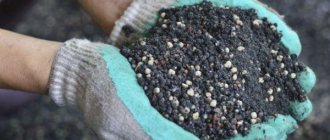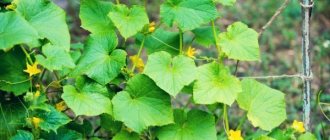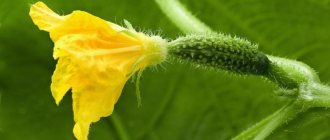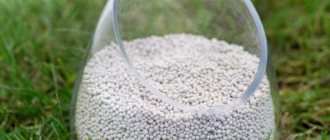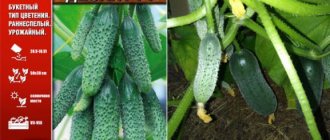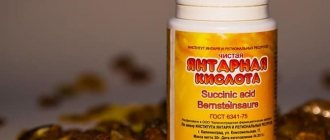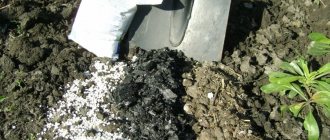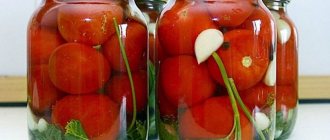The effect of boric acid on cucumbers
Boron ions are contained in the soil in negligibly small quantities and amount to less than a millionth part. However, the full development of cucumbers without this element is impossible.
The most accessible source of water-soluble and biologically available boron is boric acid. It can be easily purchased in powder form at a pharmacy.
Reference. Almost all boron-containing fertilizers are produced on the basis of boric acid.
The role of boron in development and growth
Boron plays an important role in the processes of vegetation, flowering and fruiting . The main function of this element is to strengthen and maintain the integrity of cell membranes.
Bohr is also involved in:
- carbohydrate metabolism and transfer of sugars across membranes;
- synthesis of phytohormones and nucleic acids;
- regulation of the content of ionized calcium necessary for cell growth;
- respiration of plants.
Benefit
The effect of proper fertilizing with boric acid manifests itself quickly:
- the development of the root system improves;
- the intensity of flowering and the number of ovaries increases;
- the taste of cucumber increases due to increased metabolism of sugars;
- Plant resistance to adverse weather conditions, pests and diseases increases.
Signs of boron deficiency in plants
Boric acid deficiency negatively affects the development of cucumbers. You can independently determine it by the following symptoms.
Slow growth
With a lack of boric acid, the growth of the plant as a whole slows down. Stem growth begins to slow down, young leaves stop appearing, and the number of ovaries decreases. If cucumbers have stopped developing, they need to be fed with micro- and macroelements.
Appearance of leaves
The leaves look limp, dull and small. With a lack of boron, growth stops and the foliage will be distinguished by its dwarfism. The protective functions of the plant are also reduced, due to which the foliage may turn yellow, curl, or spots appear on it (late blight).
With a lack of boron, young leaves practically do not grow or remain miniature in size. With such a symptom, it is necessary to carry out boron treatment of the plant in order to save the harvest as a result.
Yellow border
A yellow border on the leaves of an adult plant most often appears due to a lack of moisture and a vitamin-mineral complex. Watering with boron will help restore the plant’s immunity and activate all intracellular processes in it.
See also: How to properly form cucumbers in open ground and greenhouses
Weak flowering
The flowering of cucumbers may slow down for various reasons, but one way or another they are all associated with a deterioration in the functioning of the plant’s immune system. Boron will help increase it. You should also eliminate other factors that may negatively affect flowering:
- watering with cold water (for watering you need to use water at room temperature);
- dense planting (there should be an average distance of 50 centimeters between bushes, depending on the variety);
- low quality seeds (it is important to use only proven high-quality seeds);
- lack of fertilizing or application of low-quality fertilizers.
Bad ovary
It happens that there are many flowers on a cucumber bush, but there is no ovary. This can also be due to a number of problems, some of which can be solved by watering with boric acid.
Increased susceptibility to disease
Leaves, flowers and fruits may turn yellow, dry out, darken, turn black, rot, etc. All these are symptoms and consequences of diseases. They arise due to the weakening of the protective functions of the plant, which arise due to deficiencies of vitamins and minerals. Boron compounds strengthen the immune system and reduce the risk of disease.
When to process
For cucumbers, it is not the total boron content in the soil that is important , but the water-soluble available compounds. Boron should be added at the first signs of deficiency.
Experienced summer residents do not recommend fertilizing with boron-containing preparations for future use . An excess of the element leads to intoxication and in some cases to the death of plants.
Signs of boron deficiency
Boron deficiency is typical for soils with high alkalinity (limed, carbonate). The primary symptoms of boron deficiency appear at the cellular level. The cell walls thicken, the content of pectin substances increases.
Microelement deficiency is signaled:
- inhibition of growth points, dwarfism;
- slow pollen maturation and reduction in the number of ovaries;
- falling of buds and ovaries;
- crooked, bent cucumbers with low taste;
- shortened internodes;
- fragility and death of side shoots;
- underdeveloped root system with thickenings at the ends of the roots.
Application at different stages of development
Treatments with boric acid for cucumbers are useful from germination from seed to fruiting period.
Before sowing
Soaking seeds in boric acid solutions improves germination , additionally disinfects and saturates with nutrients. After pickling, the cucumber seeds are placed in the drug solution for about 12 hours. To prevent the seeds from floating, they are wrapped in gauze.
The soaking liquid is prepared by dissolving 0.2 g of boric acid powder in 1 liter of hot water. The resulting mixture is cooled and used for its intended purpose.
When growing seedlings
Cucumber seedlings are sprayed after transplanting into the ground . Use approximately 30 ml of solution per sprout. This procedure helps the sprout take root better and improves immunity.
You can also treat bushes grown without seedlings at the stage of 4-5 true leaves.
During the flowering and fruiting period
Boron acquires particular importance during the period of flowering , laying and filling of fruits.
Fertilizing with boric acid increases plant immunity . Without harming fruiting, cucumbers tolerate short-term lack of moisture or a sharp drop in temperature. Cucumbers acquire sweetness and aroma.
It can be useful:
What to do if cucumber seedlings turn yellow
Why gray rot appears on cucumbers and how to deal with it
Use of boron
We recommend reading our other articles
- Application of pesticides
- Why doesn't geranium bloom?
- Summer miracle berry
- Wild garlic
Boric acid for cucumbers as a fertilizer is useful throughout the growing season of the crop.
Before sowing
At this stage, you can soak the seeds in a boric acid solution. This treatment will increase the percentage of germination and disinfect the seeds. How to dilute this product? To do this, 0.2 g of the drug must be mixed with a liter of hot water. Then the mixture must be stirred and cooled. The seeds are placed in gauze, placed in a saucer and filled with this solution. Soaking lasts 12 hours, no more, after which you need to dry the seeds and only then sow.
Important!
You cannot water adult cucumbers with a hot solution of boric acid. It is always cooled before use.
At the sowing stage, you can soak the seeds in a solution of boric acid
During seedling development
While the seedlings are small, spraying is not required, but after transplanting the seedlings into the ground, it is worth treating with boron. How to prepare fertilizer? The solution is made as in the previous case - 0.2 g of boric acid per liter of hot water. Each sprout requires 30 ml of liquid. Thanks to this feeding, cucumbers will quickly take root in a new place, their defenses will be activated, which will help avoid diseases at an early stage of development.
If cucumbers are grown using the seedless method, they are fed with the same solution at the stage of 4-5 developed leaves. The dilution proportions of the product and the dosage of the working fluid are the same.
During the appearance of flowers and fruits
You can fertilize plants with boric acid not only while they are small, but also when they begin to produce flowers or even fruits. How to dilute boric acid was described above, although at this stage you can make other proportions, it all depends on what effect you want to achieve. Boric acid is first diluted in hot water, then cooled and used for watering or spraying plants.
This feeding is very important during flowering and for fruit set. It also doesn’t hurt when pouring cucumbers so that they have a better taste. In addition, spraying with boron fertilizer increases the immunity of the crop. Thanks to this feeding, it becomes easier for plants to tolerate summer temperature fluctuations, frequent rains or drought. The use of such fertilizing can be carried out 1-3 times, depending on the needs of the gardener.
Interesting!
Boric acid should be poured into hot water (50-70 degrees), because it does not dissolve well in cold water.
How to prepare the solution correctly
It is not difficult to prepare a solution of boric acid; the main thing is not to make a mistake with the dosage. For any type of plant feeding, use only powder , and in no case an alcohol solution.
Important! The use of solutions with high concentrations leads to leaf burns.
The substance is poorly soluble in cold water . The powder is first diluted in a small amount of hot (50-70ºС) water, and then brought to the required volume with cold water. The resulting liquid is used immediately.
Solution proportions
The optimal concentration of boric acid solution is 5 g (1 level teaspoon) per 10 liters of water. If less product is required, take 0.5 g of powder for each liter of water.
Recipes with various additives
Additives enhance the positive effects of boric acid solution on cucumbers.
The table shows several recipes from experienced gardeners.
| № | How to cook | Result | Dosage and method of administration |
| 1. | 0.5 tsp. dissolve boric acid powder in a glass of hot water, pour into a bucket of cold water, add 2 tbsp. l. ammonia and several crystals of potassium permanganate. | Stimulation of flowering and fruit formation. Destruction of aphids and pathogenic bacteria. | Spray 50 ml per bush during budding. |
| 2. | Dilute 1.5 g of boric acid and several crystals of potassium permanganate in 200 ml of hot water. Pour the mixture into a glass of milk and add 60 drops of iodine and 1 tbsp. l. urea. Bring the volume of liquid to 10 liters with cold water. | Acceleration of growth of leaf mass and ovaries. Increased immunity to fungal infections. | Spray at the beginning of flowering and during fruiting with about 100 ml per 1 m². |
| 3. | 0.5 tsp. dilute acids in 10 liters of water, add 200 ml of chlorella suspension diluted with 1 liter of warm water. | Increasing the vitality of plants, preventing fungal and bacterial infections. | Treat one leaf at a time during flowering and fruit formation, 50 ml per plant. |
| 4. | 1 tsp. dissolve the powder in 10 liters of warm water, add 100 g of honey or sugar. | Attracting bees for pollination. | Spray on flowering cucumbers in open ground at the rate of 100 ml per 1 m². |
How to process
Available forms of boron in soils are represented by boric acid and its water-soluble salts . These compounds are weakly fixed in the soil and are easily washed out by precipitation. For this reason, fertilizing with boric acid is carried out on the leaf.
During the season, it is enough to treat the cucumber plantings with boric acid 3 times : when buds appear, during the flowering period and during mass fruit set.
When feeding plants with a solution, you must adhere to two rules:
- spray cucumber beds in calm, dry weather, early in the morning or in the evening;
- When spraying, evenly moisten the entire surface of the sheet with the solution.
Benefits and harms
If you dilute boric acid in the correct proportion and feed the cucumbers in a timely manner, then this fertilizer will be:
- will ensure an increase in oxygen concentration in the soil;
- normalizes nitrogen synthesis, thereby improving the ovary;
- saturates future fruits with calcium;
- stimulates root development;
- increases resistance to adverse factors;
- enhances the production of chlorophyll, due to which the leaves acquire a rich green color;
- stimulates metabolic processes, which has a positive effect on the taste of fruits.
See also
Description of the cucumber variety Bjorn F1, cultivation and pest control
Read
However, if the rules for adding boric acid to the garden are not followed, the use of the product on cucumbers is dangerous. If you frequently spray the solution, the leaves turn yellow, curl and fall off. In addition, an increase in boron concentration in cucumbers is dangerous for humans (especially for people with kidney pathologies).
Tips and tricks
Some tips from summer residents on the use of boric acid:
- Boric acid powder will help get rid of house ants. It is necessary to scatter the drug in those places where insects most often appear: behind baseboards, near the trash can, under kitchen cabinets. For a better effect, you can mix the acid with sugar or jam.
- A solution of boric acid can be used to treat not only cucumbers, but also tomatoes, potatoes, cabbage and other vegetables.
- If you treat strawberries with a standard boric acid solution twice a season, the berries will be sweeter.
